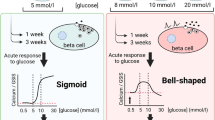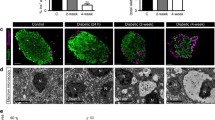Summary
Isolated fetal islets show an immature or poor secretory response to nutrient secretagogues which may result from impaired mitochondrial oxidative processes. Insulin secretion, glucose metabolism and detection of metabolic enzymes by radiolabelling and immunoprecipitation were compared in islets isolated from neonatal (aged 5 days) and fetal rats (at 20 days gestation). The insulin secretory dynamics of fetal islets were abnormal in response to stimulation by glucose (10 mmol/1); a rapid release of insulin reaching a maximum 6 min after stimulation was observed with no rising second phase release. However, when the data were expressed as percentage of islet insulin content released, fetal islets released significantly more insulin than neonatal islets in response to glucose (4.86 ± 0.45 % vs 1.81 ± 0.62 %, p < 0.01) or 100 nmol/1 glibenclamide (2.49 ± 0.17% vs 0.25 +- 0.06 %, p < 0.001). Fetal islets however, failed to release insulin in response to stimulation by glyceraldehyde (10 mmol/1) unlike neonatal islets. Both glucose utilisation (as measured by the formation of [3H] H2O from 5-[3H] glucose) and glucose oxidation (as measured by the formation of [14C] CO2 from U-[14C] glucose) did not increase significantly in response to increasing the medium glucose concentration to 10 mmol/1 whereas in neonatal islets, glucose utilisation and glucose oxidation were significantly increased 2.5- and 2.7-fold, respectively. When islets were incubated with both radiolabelled glucoses simultaneously, the rate of glucose oxidation was shown to be directly proportional to the rate of glucose utilisation. The relationship between glucose utilisation and glucose oxidation was similar in fetal and neonatal islets. Finally, in experiments to detect and semiquantify metabolic enzymes, the level of GLUT-2 transporter protein was significantly reduced by 50 % (p < 0.02) whereas the levels of pyruvate dehydrogenase peptides were similar in fetal and neonatal islets. In conclusion, these data do not support the hypothesis that abnormal mitochondrial oxidation is responsible for the immature secretory responses to nutrient secretagogues found in fetal islets but rather that step(s) earlier in the glycolytic pathway are important for development of normal secretory function.
Similar content being viewed by others
References
Prentki M, Matschinsky FM (1987) Ca2+, cyclic AMP and phospholipid derived messengers in coupling mechanisms of insulin secretion. Physiol Rev 67: 1185–1248
Arkhammar P, Nilsson T, Rorsman P, Berggren P-O (1987) Inhibition of ATP-regulated K+ channels precedes depolarisation-induced increase in cytoplasmic free calcium concentration in pancreatic beta cells. J Biol Chem 262: 5448–5454
Ashcroft FM, Ashcroft SJH (1990) Properties and functions of ATP-sensitiveK+ channels. Cellular Signalling 2: 197–214
Asplund K, Westman S, Hellerström C (1969) Glucose stimulation of insulin secretion from the isolated pancreas of fetal and newborn rats. Diabetologia 5: 260–262
Sodoyez-Goffaux F, Sodoyez JC, Fao PP (1971) Effect of gestational age, birth and feeding on the insulinogenic response to glucose and tolbutamide by fetal and newborn rat pancreas. Diabetes 20: 586–591
Sodoyez-Goffaux F, Sodoyez JC, De Vos CJ, Fao PP (1979) Insulin and glucagon secretion by islets isolated from fetal and neonatal rats. Diabetologia 16: 121–123
Freinkel N, Lewis NJ, Johnson R, Swenne I, Bone A, Hellerström C (1984) Differential effects of age versus glycemic stimulation on the maturation of insulin stimulus-secretion coupling during culture of fetal rat islets. Diabetes 33: 1028–1038
Ammon HPT, Fahmy A, Mark M, Strolin W, Wahl MA (1985) Failure of glucose to affect rubidium efflux and calcium uptake of fetal rat pancreatic islets. J Physiol 358: 365–372
Mourmeaux JL, Remacle C, Henquin JC (1989) Effects of stimulation of adenyl cyclase and protein kinase C on cultured fetal rat B-cells. Endocrinology 125: 2636–2644
Ammon HP, Glocker C, Waldner RG, Wahl MA (1989) Insulin release from pancreatic islets of fetal rats mediated by leucine, BCH, tolbutamide, glibenclamide, arginine, potassium chloride and theophylline does not require stimulation of net calcium uptake. Cell Calcium 10: 441–450
Rorsman P, Arkhammar P, Bokvist K et al. (1989) Failure of glucose to elicit a normal secretory response in fetal pancreatic beta cells results from glucose insensitivity of the ATP-regulated K+ channels. Proc Natl Acad Sci USA 86: 4504–4509
Heinze E, Steinke J (1971) Glucose metabolism of isolated pancreatic islets: difference between fetal, newborn and adult rats. Endocrinology 88: 1259–1263
Wahl MA, Waldner RG, Ammon HPT (1992) Potassium permeability of fetal rat pancreatic islets: abnormal sensitivity to glucose. Life Sci 51: 1631–1637
Brunstedt J, Nielsen JH, Lernmark Å (1984) Isolation of islets from mice and rats. In: Larner J, Pohl SL (eds) Methods in diabetes research, Vol I. Laboratory methods, part C. John Wiley and Sons, New York, pp 245–258
Hughes SJ, Carpinelli A, Niki I, Nicks J, Ashcroft SJH (1992) Stimulation of insulin release by vasopressin in the clonal B-cell line HIT-T15: the role of protein kinase C. J Mol Endocrinol 8: 145–153
Ashcroft SJH, Crossley JR (1975) Effects of glucose, n-acetylglucosamine, glyceraldehyde and other sugars on insulin release in vivo. Diabetologia 11: 279–284
Sener A, Malaisse WJ (1987) Stimulation by glucose of mitochondrial oxidative events in islet cells. Biochem J 246: 89–95
Hughes SJ, Ashcroft SJH (1988) Effect of a phorbol ester and clomiphene on protein phosphorylation and insulin release in rat pancreatic islets. Biochem J 249: 825–830
Christie M, Landin-Olsson M, Sundkvist G, Dahlquist G, Lernmark Å, Baekkeskov S (1988) Antibodies to a Mr-64000 islet cell protein in Swedish children with newly diagnosed type 1 diabetes. Diabetologia 31: 597–602
Bradford MM (1976) A rapid and sensitive method for the quantitation of microgram quantities of protein utilizing the principle of protein-dye binding. Anal Biochem 72: 248–254
Hughes SJ, Smith H, Ashcroft SJH (1993) Characterisation of calmodulin-dependent protein kinase activity in rat pancreatic islets. Biochem J 289: 795–800
Thorens B, Weir GC, Leahy JL, Lodish HF, Bonner-Weir S (1990) Reduced expression of the liver/beta cell glucose transporter isoform in glucose insensitive pancreatic beta cells of diabetic rats. Proc Natl Acad Sci USA 87: 6492–6506
Denyer G, Kerbey AL, Randle PJ (1986) Kinase activator protein mediates longer-term effects of starvation in activity on pyruvate dehydrogenase kinase in rat liver mitochondria. Biochem J 239: 347–354
Grill V, Lake W, Freinkel N (1981) Generalised diminution in the response to nutrients as insulin-releasing agents during the early neonatal period in the rat. Diabetes 30: 56–63
Bliss C, Sharp GWG (1992) Glucose induced insulin release in islets of young rats: time-dependent potentiation and effects of 2-bromostearate. Am J Physiol 263: E890-E896
Kervan A, Randon J (1980) Development of insulin release by fetal rat pancreas in vitro. Diabetes 29: 673–678
Randon J, Kervan A (1979) Cinetique du la secretion d’insuline en reponse au glucose par les ilots de Langerhans isoles de foetus de rat. C R Acad Sci Paris 228: 1567–1570
Hole RL, Pian-Smith MCM, Sharp GWG (1988) Development of the biphasic response to glucose in fetal and neonatal rat pancreas. Am J Physiol 254: E167-E174
Ashcroft SJH, Hughes SJ (1990) Protein phosphorylation in the regulation of insulin secretion and biosynthesis. Biochem Soc Trans 18: 116–118
Portha B, Giroix M-H, Serradas P et al. (1988) Insulin production and glucose metabolism in isolated pancreatic islets of rats with NIDDM. Diabetes 37: 1226–1233
Malaisse WJ (1992) Regulation of insulin secretion by nutrients: the fuel concept. In: Flatt PR (ed) Nutrient regulation of insulin secretion. Portland Press, London, pp 83–101
Agren A, Andersson A, Hellerström C (1976) Effect of D-glyceraldehyde and D-glucose on the insulin release of pancreatic islets isolated from the newborn rat. FEBS Lett 71: 185–188
Newgard CB, Quaade C, Hughes SD, Milburn JL (1990) Glucokinase and glucose transporter expression in liver and islets; implications for control of glucose homeostasis. Biochem Soc Trans 18: 851–853
Chen L, Alam T, Johnson JH, Hughes S, Newgarde CB, Unger RH (1990) Regulation of B-cell glucose transporter gene expression. Proc Natl Acad Sci USA 87: 4088–4092
Orci L, Ravazzola M, Baetens D et al. (1990) Evidence that down-regulation of B-cell glucose transporters in NIDDM may be the cause of diabetic hyperglycemia. Proc Natl Acad Sci USA 87: 9953–9957
Randle PR (1986) Fuel selection in animals. Biochem Soc Trans 14: 799–806
McCormack JG, Longo EA, Corkey BE (1990) Glucose induced activation of pyruvate dehydrogenase in rat pancreatic islets. Biochem J 267: 527–530
Ashcroft SJH, Stubbs M (1987) The glucose sensor in HIT cells is the glucose transporter. FEBS Lett 219: 311–315
Meglasson MD, Matschinsky FM (1986) Pancreatic islet glucose metabolism and regulation of insulin secretion. Diabetes Metab Rev 2: 163–214
Lenzen S (1992) Glucokinase; signal recognition enzyme for glucose-induced insulin secretion. In: Flatt PR (ed) Nutrient regulation of insulin secretion. Portland Press, London, pp 101–125
Author information
Authors and Affiliations
Rights and permissions
About this article
Cite this article
Hughes, S.J. The role of reduced glucose transporter content and glucose metabolism in the immature secretory responses of fetal rat pancreatic islets. Diabetologia 37, 134–140 (1994). https://doi.org/10.1007/s001250050083
Received:
Revised:
Issue Date:
DOI: https://doi.org/10.1007/s001250050083




